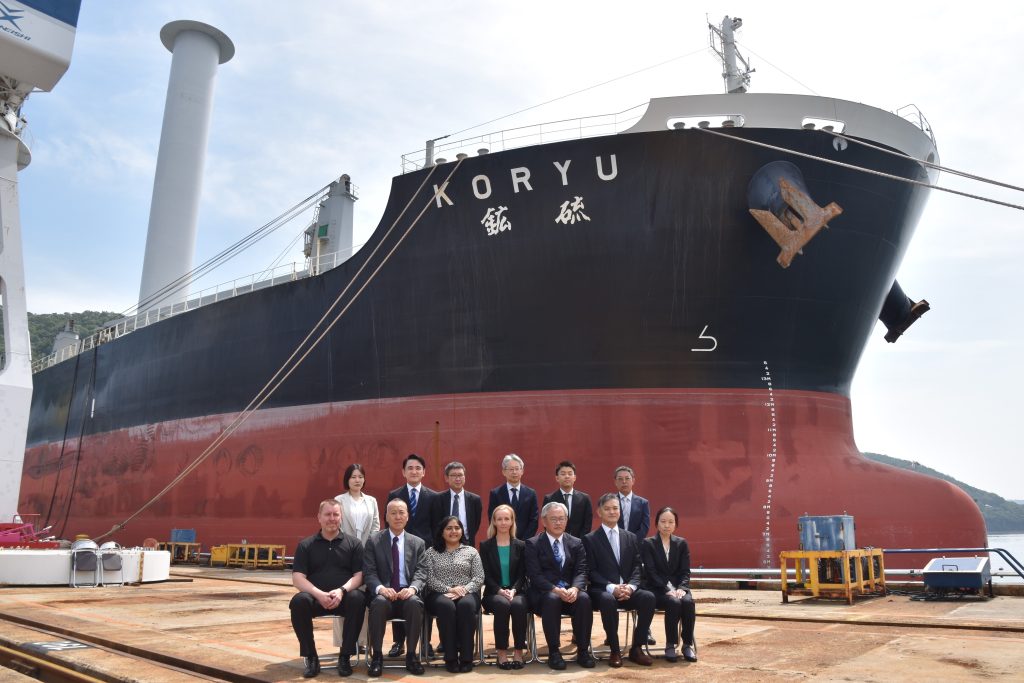
BHP, together with Pan Pacific Copper (PPC) and Norsepower, completed the retrofit installation of a Norsepower Rotor Sail? (NPRS?) onboard the M/V Koryu, a combination carrier operated by Nippon Marine (member of the SENKO group and owned by SENKO (60%) and JX Advanced Metals (40%)) that will carry copper concentrates from Chile to Japan and sulphuric acid from Japan to Chile. The NPRS? installation was carried out in June 2024, and the M/V Koryu is en route on her maiden voyage post NPRS? installation from Japan to Chile.
The rotor sail, standing 35 metres tall with a diameter of 5 metres, has a tilting foundation that allows it to be lowered down to facilitate cargo loading and discharge operations at ports.
The Norsepower Rotor Sail? is a modernised version of the Flettner rotor. The technology is based on the Magnus effect, that harnesses wind to improve ship fuel efficiency. When wind conditions are favorable, NPRS? allows the vessel’s main engines to be throttled back, saving fuel and reducing greenhouse gas (GHG) emissions by reducing the power needed to maintain speed and voyage time.
The parties had previously
announced the partnership to collaborate on the initiative with the aim of reducing GHG emissions from maritime transportation between Chile and Japan.
Based on advanced simulations and Norsepower’s real-world performance data, the use of NPRS? is estimated to provide a 5-6 percent fuel savings, on average, on the route between Chile and Japan and is expected to make M/V Koryu the best performing vessel in its category when measured for the vessel’s GHG emissions intensity.
BHP, PPC and Norsepower will be monitoring the NPRS? performance onboard the M/V Koryu to determine the actual fuel savings and associated GHG emissions reduction.
BHP’s Vice President Maritime & Supply Chain Excellence, Rashpal Bhatti, said: “There are multiple onboard innovations that have potential to achieve GHG emissions reduction in the maritime supply chain and we are pleased to have collaborated with PPC and Norsepower, our like-minded ecosystem partners, to retrofit the Norsepower Rotor Sail? on M/V Koryu to reduce shipping GHG emissions intensity on our Chile-Japan trade route. This route has one of the most favorable wind conditions, which was an important factor that the parties considered. It is one of the longest routes globally with such conditions, allowing the vessel to benefit from the longest ton/mile wind propulsion.”
Tomonori Uemura, Executive Officer of PPC, said: “PPC is delighted that we were able to complete the installation of the Norsepower Rotor Sail? onboard M/V Koryu successfully. This project, which aims to reduce GHG emissions intensity in maritime transportation between Japan and Chile, is a symbol of our cooperation with our partners to progress towards a decarbonised society, and we look forward to seeing the rotor sail’s performance.”
Heikki P?ntynen, CEO of Norsepower, said: “We are proud to collaborate with BHP and PPC on this project, which marks a significant step towards more sustainable shipping for the M/V Koryu. This partnership exemplifies how industry leaders can come together to drive positive environmental change. The successful retrofit of Norsepower Rotor Sail? will reduce greenhouse gas emissions intensity by enhancing fuel efficiency in the ship. We look forward to tracking the measurable impact of this installation in real-world operations.”
Source: Norsepower

